Content
- 1 Red currant varieties for central and central Russia
- 2 Early ripening varieties
- 3 The largest varieties
- 4 Winter hardy varieties
- 5 The best varieties of red currants for the Moscow region
- 6 The best varieties of red currant
- 7 The best varieties of red currant for the Moscow region
- 8 The best varieties of red currants for Siberia and the Urals
Many gardeners grow red currants on their site. This berry has a pleasant taste and many beneficial properties.... Most often, bright fruits are processed, but there are also large-fruited varieties that are perfect for fresh consumption, for example, Ilyinka or Alpha. The best varieties for the central region are considered to be Roseta, Rondom, Natalie and Gollandskaya krasnaya, but the most winter-hardy variety is the Uralskaya krasavitsa.
Red currant varieties for central and central Russia
The main indicator that the red currant variety is suitable for the middle lane is its resistance to frost and drought. The changeable climate of the central region allows only strong plants to be grown. As for the taste, size and other characteristics of the berries, each gardener chooses for himself individually. The best representatives of the varieties in this category are:
Darling
 Red currant variety Beloved
Red currant variety Beloved
The variety is the result of the work of Belarusian breeders. A medium-sized shrub with a rounded, not dense crown. Berries are light red, small in size, weighing up to 0.5 grams... Also, the variety is distinguished by high yields and self-fertility, tolerates frosts well, fruits tolerate transportation well. The downside is susceptibility to fungal diseases.
Roland
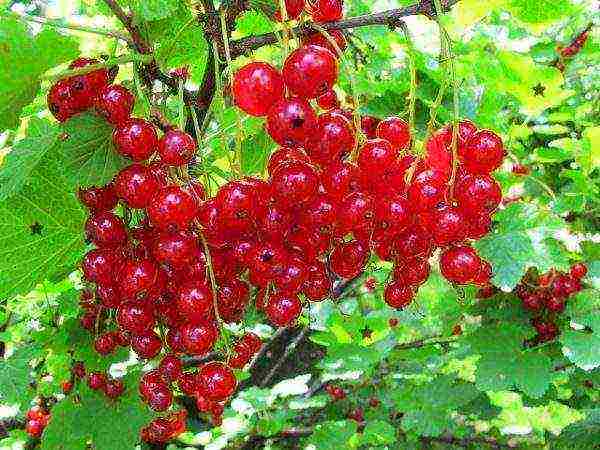 Red currant grade Roland
Red currant grade Roland
Dutch variety, medium-sized shrub with thick shoots, tolerates frost well and brings 6-7 kilograms of harvest... The berries are scarlet, weighing from 0.7 to 1.5 grams. Suitable for processing, and when overripe, it is used for fresh consumption. The taste is sour. Roland is not susceptible to fungal diseases, but there is a threat of attack by currant kidney mites.
Red Cross
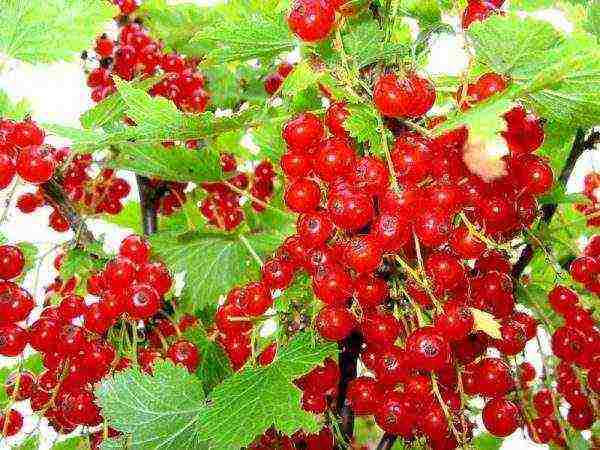 Currant grade Red cross
Currant grade Red cross
This type of currant was bred in the United States. Shrub of medium height with a wide, spreading crown. The berries are small, their weight is 0.5 grams... The color of the flesh is red, but the skin is transparent. The variety is distinguished by self-fertility and winter hardiness, and is immune to many diseases.
Varieties of early ripening of berries
Shrubs belonging to the early ripening period can be harvested at the end of June... This indicator attracts the attention of many gardeners who want to eat fresh berries as early as possible. The following varieties are considered the most popular:
Jonker van Tets
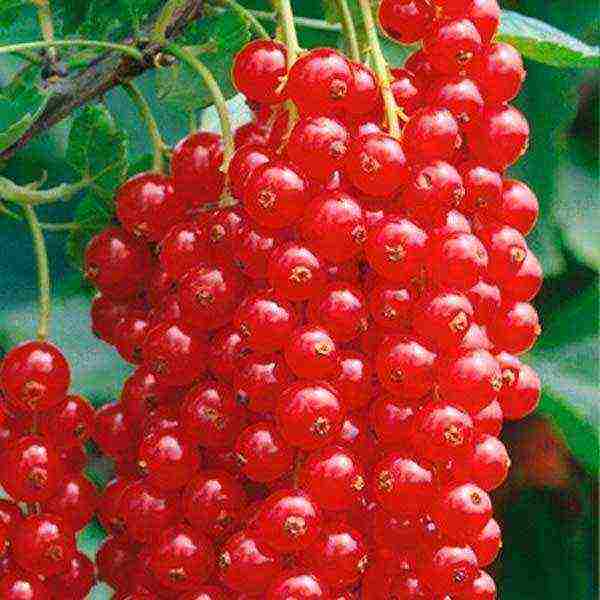 Red currant grade Jonker van Tets
Red currant grade Jonker van Tets
One of the oldest varieties, it was bred in Holland in 1941 and to this day attracts the attention of many gardeners. The bush is tall with many branches. The berries of such a plant are medium in size, up to 0.7 grams, with a delicate, sweet and sour taste... The fruits ripen early. Also, the variety has a good and stable yield and relative self-fertility. Best of all, the shrub adapts to the conditions of the central region. Such currants are not afraid of winter cold and have a good immunity to powdery mildew and anthracnose.
Early sweet
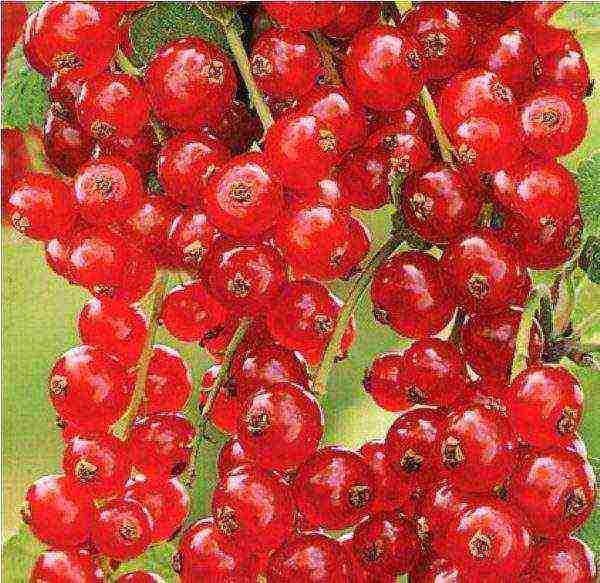 Red currant variety Early sweet
Red currant variety Early sweet
Early ripening variety.A medium-sized shrub with a thin, neat crown. Berries are large enough, in terms of their weight, they can reach 0.9 grams... The color of the skin is dark red, the pulp has a pleasant taste, and is sour. It is appreciated for its high resistance to frost and drought.
Cherry Viksne
 Currant Cherry Viksne
Currant Cherry Viksne
This variety is very often used commercially. Latvia is considered the birthplace of breeding, therefore in Russia it is customary to grow it in the European part. Small shrubs annually bring a bountiful harvest of medium-weight berries (0.8 grams)... The color of the currant is bright red, it also has good transportability and a long shelf life. Resistant to frost, drought and anthracnose.
Chulkovskaya
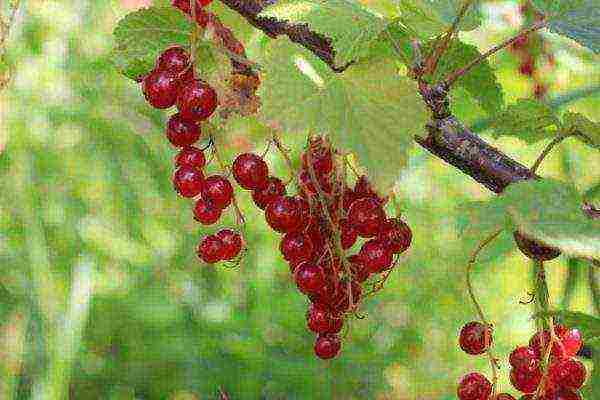 Red currant grade Chulkovskaya
Red currant grade Chulkovskaya
In Russia, this variety has been cultivated since 1947. The shrub is tall, the crown is compact and neat, it has good self-fertility and does not need pollinators. On average, one berry weighs 0.7 grams, the taste is pleasant, but best suited for various types of processing... Resistance to frost, diseases and insects is average. But at the same time, the variety tolerates the absence of precipitation and dry weather well.
The largest varieties
Usually, red currants are used to make stewed fruit, juices, preserves and other processed products. But large-fruited varieties are suitable for fresh consumption, because they have excellent taste:
Ilyinka
 Red currant grade Ilyinka
Red currant grade Ilyinka
It is a medium-sized shrub with a bountiful and annual harvest. The fruits ripen in the middle of summer and have a very large mass, which can reach 1.6 grams.... The peel of the berries is dark red, almost burgundy in color, the taste is at the highest level. In addition, the variety perfectly tolerates winter frosts, is not exposed to most diseases and pests.
Asora
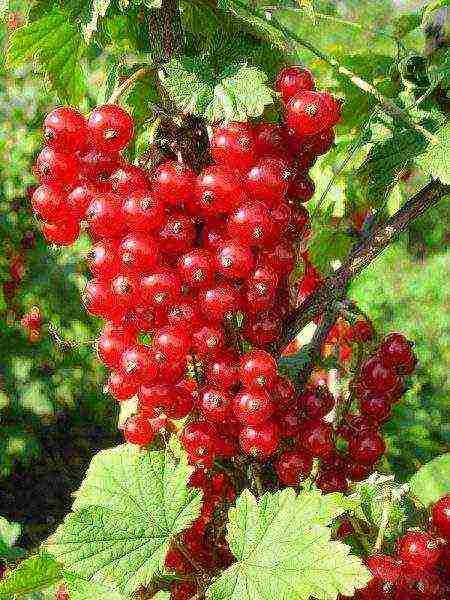 Red currant Asora grade
Red currant Asora grade
Shrub of medium height with powerful, spreading branches. A variety of late ripening, fruits of a rich maroon color weighing up to 1 gram... Asora is not afraid of moderate cold weather, is not susceptible to various diseases and attacks of pests.
Alpha
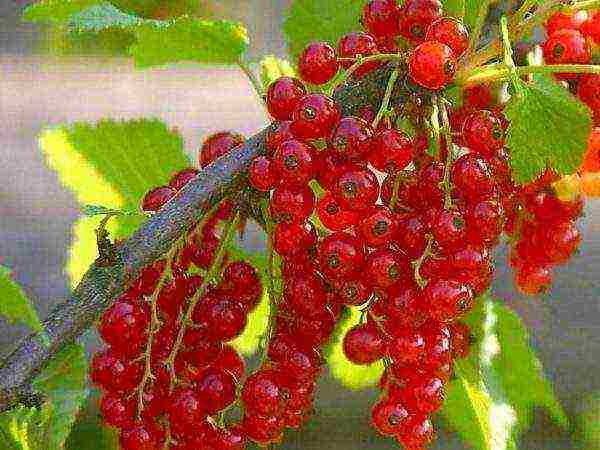 Red currant grade Alpha
Red currant grade Alpha
This variety appeared on the garden market relatively recently, but has already managed to win the attention of many summer residents. A medium-sized bush produces a stable and high yield. Berries of a light red hue and with a sweet taste can reach up to 1.5 grams in weight... Also, the variety is self-fertile, is not afraid of severe cold weather and is not susceptible to the appearance of powdery mildew.
Baraba
 Red currant variety Baraba
Red currant variety Baraba
The medium-ripening variety is a short, compact shrub that produces a good harvest every year. Deep red berries, on average, weigh 1.5 grams... The variety has high frost resistance and is not affected by drought. The only drawback is susceptibility to anthracnose.
Winter hardy varieties
Gardeners living in areas with a harsh climate also grow red currants on their plots. AND to get a good harvest and maintain the viability of the shrub, it is necessary to choose the right variety, which will be characterized by high winter hardiness:
Ural beauty
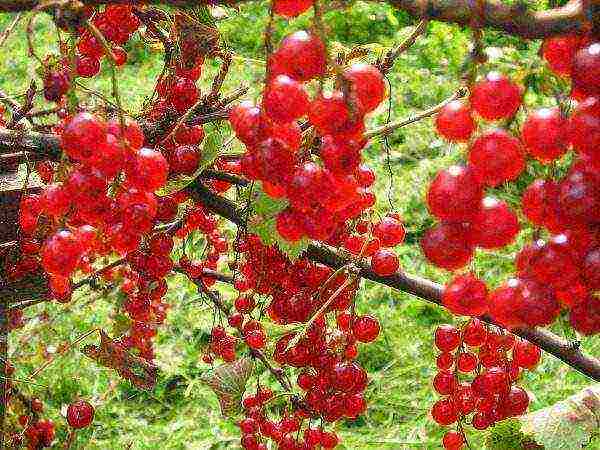 Red currant grade Ural beauty
Red currant grade Ural beauty
One of the most frost-resistant varieties, a low shrub with a powerful, branched crown gives annual and bountiful harvests. Large berries (1.7 grams) have a pleasant sweet taste and aroma... The Ural beauty does not need additional pollination, is not susceptible to the appearance of diseases and pests.
Ural fires
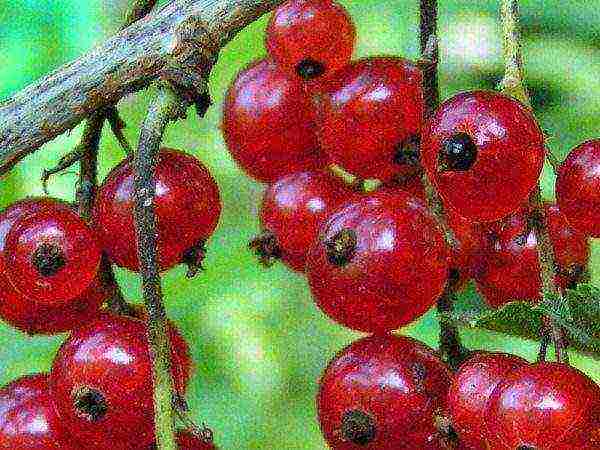 Red currant grade Fires of the Urals
Red currant grade Fires of the Urals
This variety was bred relatively recently, in 2000. A tall shrub with powerful, dense branches, it tolerates frost well and is partially self-fertile. Medium-sized berries (0.5 - 0.7 grams), the skin is bright red, the flesh is sweet, with a slight sourness... In addition to all the other advantages, such a shrub is immune to many fungal diseases.
Scarlet dawn
 Red currant grade Scarlet Dawn
Red currant grade Scarlet Dawn
A medium-sized shrub with a rectangular, even crown. Fruits ripen in medium terms, and are red berries weighing up to 1 gram... The taste of the pulp is sweet and sour; such currants are well suited both for processing and for fresh consumption. The variety is fruitful, self-fertile, not affected by many diseases and has a high winter hardiness.
The best varieties of red currants for the Moscow region
For the Moscow region, the same varieties may be suitable as for the central region... The most popular are the red currants Rondom and Natali, these varieties have the largest and most delicious berries.
Rondome
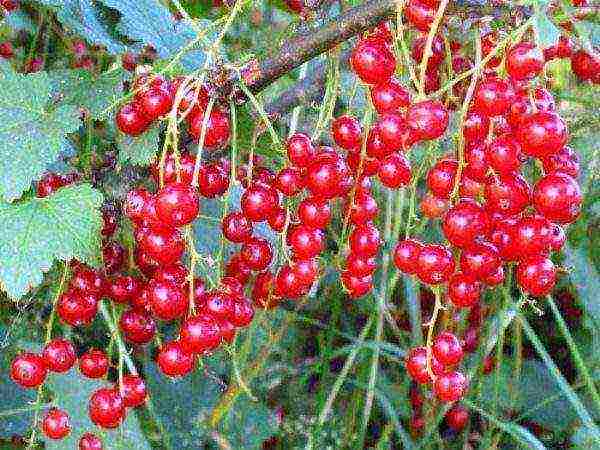 Red currant grade Rondom
Red currant grade Rondom
The variety was developed by Dutch breeders. High shrub, branched with powerful shoots, fruit ripening occurs at a later date... The yield is not very high, but stable. Berries differ from other varieties in their high content of vitamin C, they also do not crumble after full ripening. Dark red currant weighing up to 0.9 grams suitable for fresh consumption and for processing. Rondome is perfect for growing in the central region of the country.
Natalie
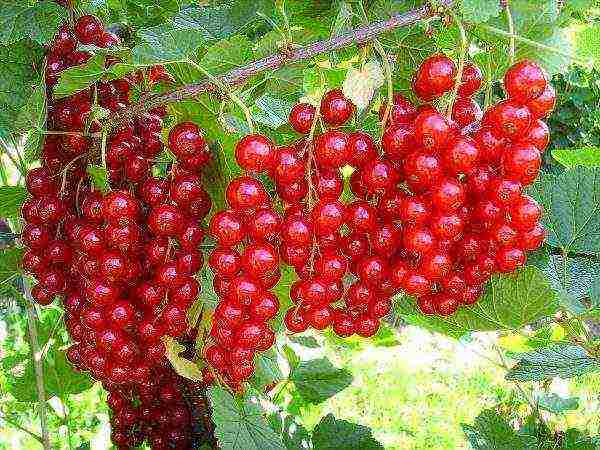 Red currant grade Natali
Red currant grade Natali
The variety is suitable for cultivation in the southern and central regions of Russia. Represents low, neat shrub, bearing large (up to 1 gram) burgundy fruits and medium ripening... The taste of the pulp is sweet and sour. The variety has a relatively high winter hardiness and good resistance to diseases and pests.
Dutch red
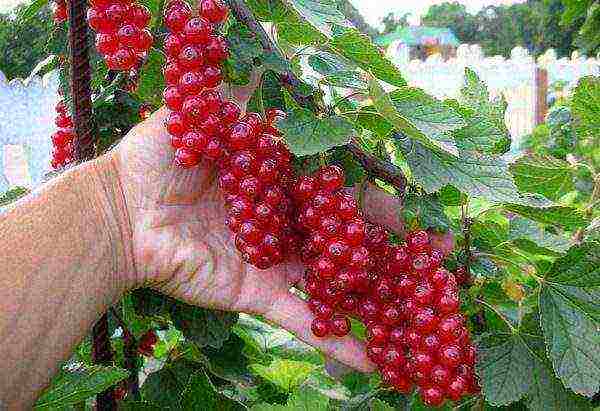 Currant variety Dutch red
Currant variety Dutch red
One of the oldest varieties grown in Europe. The shrub is high, with a rectangular crown. The fruits ripen in early August, are medium in size and have a pleasant sour taste.... Such berries are most often used for various types of processing. Holland red, like pink, tolerates drought well, but yields increase with abundant watering. It is resistant to disease.
Rosetta
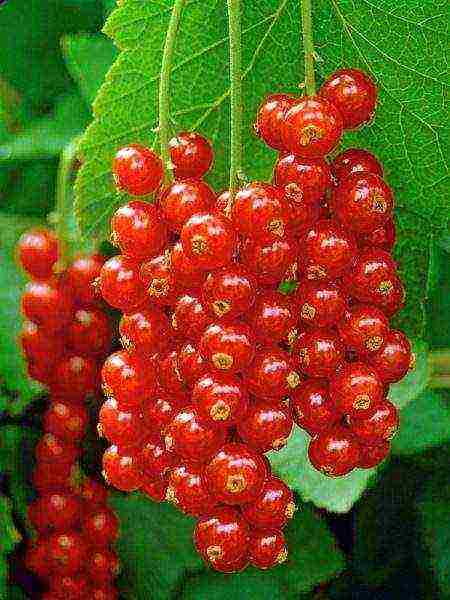 Red currant variety Rosetta
Red currant variety Rosetta
A tall shrub with strong, straight-growing branches, fast and vigorous growth. The berries ripen at the end of July, are large in size and have a pleasant sour taste.... Fruits for universal use, ripen on long clusters, up to 12 centimeters long. The variety is distinguished by strong growth, photophilousness and poor tolerance of excessive moisture.
Red currants can be found in almost any garden area, and it is not for nothing that this berry is so popular. There are a huge number of varieties, so everyone can choose the most suitable specimen for themselves.
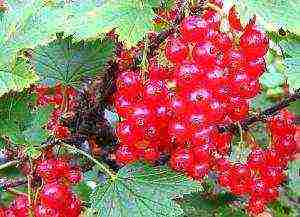 Red currant is a beloved by many, a promising crop with a stable annual yield, rare unpretentiousness, and high taste. The average yield of the best varieties of red currants is almost two times higher than that of raspberries and black currants, and an order of magnitude higher than that of gooseberries and strawberries. Its berries contain vitamin C, amino acids, P-active compounds and coumarins. This type of currant entered the culture much earlier than black currant and worthy to this day takes its rightful place in it.
Red currant is a beloved by many, a promising crop with a stable annual yield, rare unpretentiousness, and high taste. The average yield of the best varieties of red currants is almost two times higher than that of raspberries and black currants, and an order of magnitude higher than that of gooseberries and strawberries. Its berries contain vitamin C, amino acids, P-active compounds and coumarins. This type of currant entered the culture much earlier than black currant and worthy to this day takes its rightful place in it.
Red currant is popular in many countries around the world. It is grown in the USA, England, Iceland, Germany, Czech Republic, Poland, Slovakia, Estonia, Latvia, the Netherlands and not only in private gardens, but also as an industrial culture.
In Russia, red currants occupy an insignificant part of the area. The planting areas of this shrub in the Urals and Siberia are also small.Nevertheless, its high technological and taste indicators put red currants in one of the first places with first-class horticultural crops.
Red currant occupies the vastness from the European part of Russia to the Kola Peninsula and Siberia. Calmly reacts to heat, moisture, frost. High frost and drought resistance combined with shatter resistance. Resists strong winds. It is undemanding to the characteristics of the soil, but prefers chernozems, loamy and heavy loamy soils.
The best varieties of red currant
A large number of varieties of this type of currant have a remarkable ability to set berries with their own pollen. This is also one of the reasons for its unique popularity. She does not need the presence of insects that produce pollination, this culture is self-fertile, which allows her to hold the lead in the eastern regions of the country.
- The largest red currant berries can be observed in varieties such as:
Ural beauty, Rondom, Ilyinka, Ob sunset, Viksne, Asora. - Red currant varieties have the best taste:
Ural souvenir, Meat red, Early sweet. - The highest content of vitamin C can be found in berries of the currant variety:
Chulkovskaya, Vika, Gazelle, Zarya Zapolyarya, Niva, Osipovskaya, Rote Shpetlese, Ustina. - The sugar content is mostly in red currant varieties:
Houghton Castle, Red Cross, Svetlana, Red Meat. - Of no small importance for the technological characteristics, transportability is the sign of fruit breaking during collection. Such abilities are observed in currant varieties:
Star of the North, Long-leaved small, Laturnais, Dutch red. - The following varieties have a high degree of winter hardiness:
Ural Dawns Glory Sablon,, Reibi Castle, Ural Beauty, Chulkovskaya, Dawn, Melody, Ural Lights, Scarlet Dawn, Night.
Considering all the varieties of red currants considered above, the best of them, undoubtedly, can be called:
Viksne is the best red currant variety in terms of its taste and rich deep cherry color. Winter-hardy and heat-resistant variety, disease resistant.
"Gollandskaya krasnaya" is a winter-hardy variety, distinguished by its unpretentiousness. Has compact and powerful bushes. Possesses good resistance to fungal diseases.
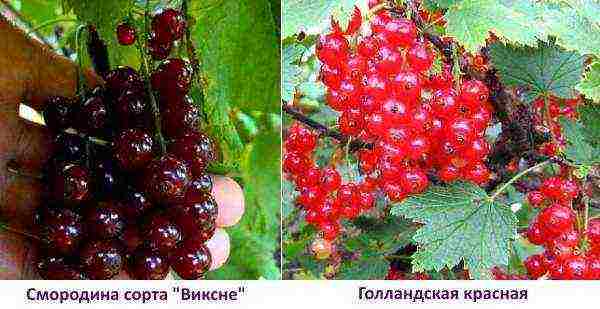
"Cascade" is a large-fruited variety of currants, has a brush 10 cm long. It is a frost-resistant variety, resistant to fungal infections. Very productive.
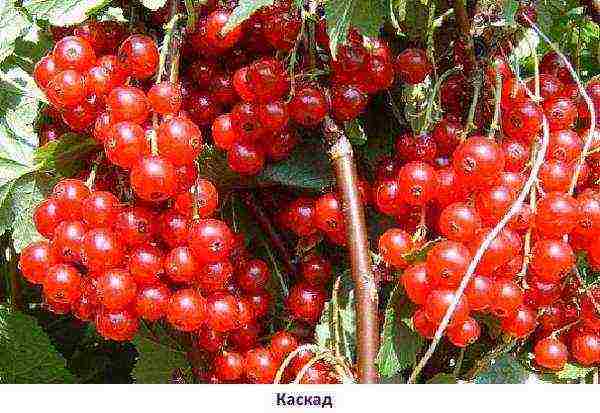
Uralskaya krasavitsa is an excellent variety. It has a dessert taste and large fruits. Early ripening currant, hardy. High productivity and self-fertility.
"Serpentine" is a large-fruited fruitful variety. Medium-sized, compact bush. Highly winter-resistant. The fruit has a wonderful taste with a pleasant aroma.
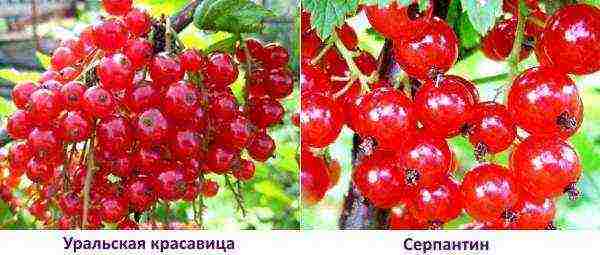
The best varieties of red currant for the Moscow region
Red currants in the Moscow region usually bloom in May. The early varieties ripen in June, the late ones in August.
For planting red currants in the specified region, such varieties are recommended as:
- Early sweet;
- Jonker van Tete;
- Rachnovskaya;
- Natalie.
"Early Sweet" is a fruitful bush that yields up to 4 kg of fruit. On a long brush, the berries are small, but tasty, do not crumble.
"Jonker van Tete" is the best of the red currant varieties, a compact tall bush that yields up to 6 kg of berries. The berries are tasty and large. Well known for its winter hardiness.
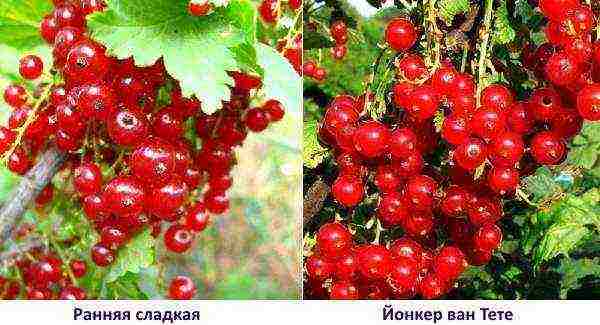
"Rachnovskaya" is a slightly spreading, medium-sized bush that yields up to 5 kg of calibrated juicy and tasty berries.
Natalie is a compact, dense bush. Productivity up to 12 kg. The berries are deep red in color, aromatic and tasty. Medium resistant to fungal diseases.
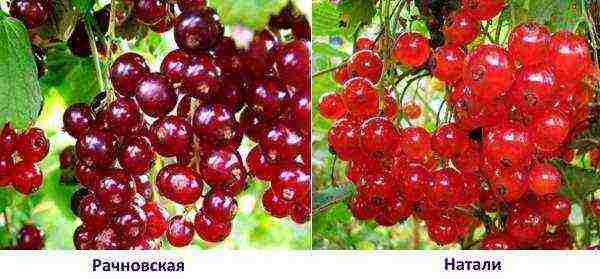
The best varieties of red currants for Siberia and the Urals
The harsh climatic conditions of Western and Eastern Siberia and the Urals have a huge impact on horticultural crops.In winter, in these regions, the temperature drops to 45 ° C, and return frosts can ruin the harvest even during flowering.
Red currant adequately overcomes these cataclysms of nature and emerges victorious from them. There are many varieties that yield good yields in Siberia and the Urals.
The best varieties of red currants for the Urals and Siberia are the following:
- Chulkovskaya;
- Dutch pink;
- Darling;
- Ural souvenir;
- Lights of the Urals.
Chulkovskaya - early red currant. Slightly spreading, vigorous, with bright red fruits from an exquisite dessert taste. High urozhnost up to 10 kg per bush. very winter hardy.
Beloved is a very popular variety. Semi-spreading, medium-sized shrub. Berries with a sweet and sour taste. Differs in excellent productivity and winter hardiness.
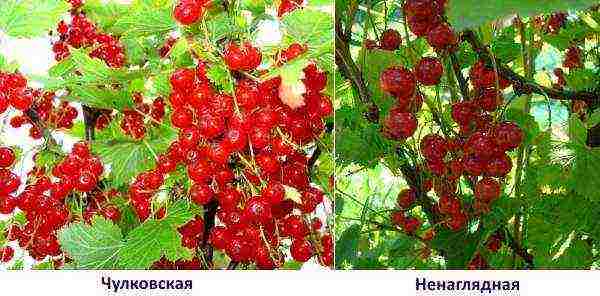
Dutch rose is a favorite variety of gardeners. Tall shrub, but compact enough. Fruits are large in size, pink in color with an excellent dessert taste. Excellent yield, cold-resistant.
The Ural souvenir is a wonderful winter-hardy variety. The berries of this variety are juicy, bright red, the taste has a sweet and sour tint. The bush is medium-sized and medium-spreading.
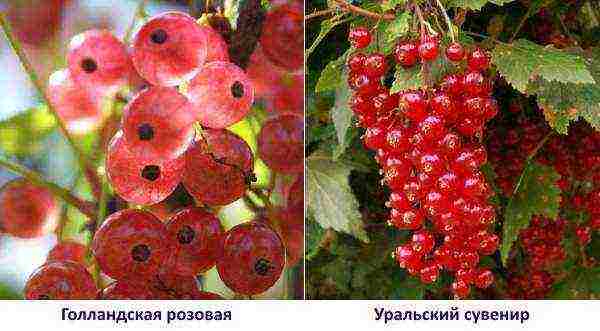
Ural Fire is a very winter-hardy variety with medium-sized berries. The flowers and ovary are resistant to spring frosts, and the plant has good resistance to pests and diseases.
Red currant varieties - video
Red currant is highly valued in our country, because from year to year it has a stable yield, the plant is relatively unpretentious to growing conditions, and the berries have excellent taste and contain a huge amount of various vitamins and substances.
Diamond (Fairy)

Mid-season fruitful variety. The bush is short, slightly spreading, has dense foliage. Fruit clusters usually do not exceed 10 cm in length. The berries are rounded, their weight ranges from 0.5-0.9 grams, the taste is delicate, sour-sweet. The variety tolerates wintering well, it is immune to most currant diseases. About 5-7 kg of berries are usually harvested from one plant.
back to contents ↑ Alpha
A high-yielding variety with medium ripening times. The bush is compact, low, wintering well. The berries are rounded, covered with light red skin, their size is rather large, the weight of one berry ranges from 0.9-1.5 grams. The fruits have a sweet-sour dessert taste. This variety of red currant is considered the best for growing in the Urals. Immune to diseases such as powdery mildew. The maximum yield per bush is 4.5 kg.
back to contents ↑ Viksne
A variety of currants with an early period of reaching the biological ripeness of the fruit. The bush is rather tall, medium spreading. The length of the fruit clusters can reach 10-15 cm, the rounded berries weigh 0.7-1 grams, each covered with a dark cherry-colored skin. The variety is valued for its medium resistance to anthracnose and dry weather, winter hardy, the average yield per bush is 5 kg.
back to contents ↑ Dutch red
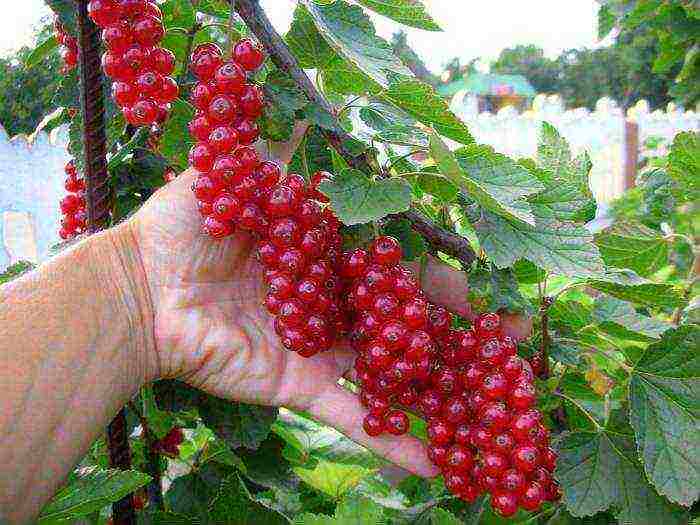
High-yielding late-ripening large-fruited variety of red currant of Western European selection. The plant is medium-sized, the foliage is dense, the bush is spreading. Clusters have an average size of up to 8 cm in length, each forms about 10-15 large berries, the diameter of which can reach 1 cm. Fruits have an elongated slightly conical shape, covered with bright red skin. This variety of red currant is adapted to the climatic conditions of the Leningrad region, winter-hardy, resistant to many fungal diseases, and the maximum yield of one bush can reach 14-16 kg.
back to content ↑
Jonker van Tets
Medium early high-yielding variety bred by Dutch breeders. The bush is compact, tall, with dense foliage.Fruit clusters are about 10 cm long, up to 10 large (0.7-1 gram) berries are formed on them, of a rounded, less often weakly pear-shaped shape with a dense bright red skin. The variety is not affected by powdery mildew and anthracnose, practically does not lend itself to infection with a kidney mite. The yield of one bush is 6-6.5 kg.
back to contents ↑ Ilyinka
A high-yielding variety with an average ripening period. The bush is medium-sized, medium-spreading, with dense foliage. Fruit clusters are up to 8 cm long, the berries are large, can weigh from 0.9 to 1.5 grams, their shape is rounded, covered with dark red skin, the taste is sweet-sour dessert. The variety tolerates wintering well, has resistance to such a common disease as powdery mildew, practically does not become infected with anthracnose, up to 5 kg of harvest is usually harvested from one plant.
back to contents ↑ Red Cross
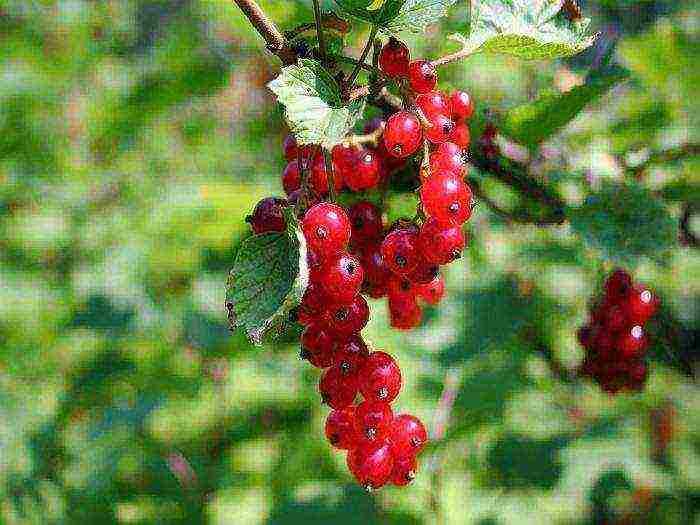
Mid-season currant variety bred by US breeders. The bush is low, spreading, the foliage density is average. The length of the fruit clusters does not exceed 7 cm, the berries have a rounded, slightly depressed shape, rather large (0.8-1.2 grams), covered with a red skin. The variety is winter-hardy, but the resistance to diseases of currants and pests is average. About 3 kg of berries can be harvested from each plant.
back to contents ↑ Fruit jelly
Representative of late-ripening large-fruited varieties of red currant. The bush is quite tall, spreading with sparse foliage. Fruit clusters of medium size (9-11 cm) are formed on them about 11 large berries, which can weigh 0.6-0.9 grams each. The shape of the fruit is oval-rounded, the skin is dense, orange-red, the berries can be on the branches of the bush for a long time without losing their taste. The variety belongs to the winter-hardy, is immune to disease, the harvest is collected about 6-8 kg from the bush.
back to contents ↑ Natalie
One of the best and most popular varieties of red currant with an average ripening period, bred by Moscow breeders. The bush is low, slightly spreading, with dense foliage. Fruit clusters stretch up to 9 cm in length, the berries are large (0.7-1 grams), their shape is elongated, and the dense skin has a rich red color. The berries can be transported over long distances, the variety is frost-resistant and immune to diseases, the amount of harvest from each bush is about 4 kg.
back to contents ↑ Beloved
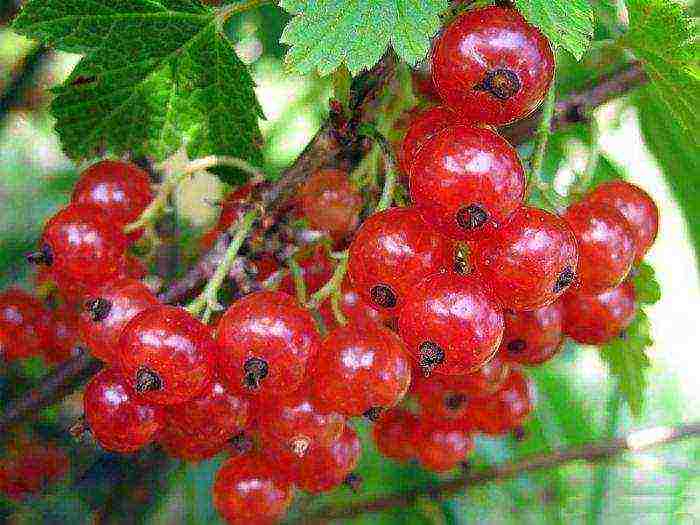
Yielding mid-season variety of Belarusian selection. The bush is medium-sized, semi-spreading, the foliage density is medium. Fruit clusters are 7-8 cm long, the berries are round in shape, their weight usually does not exceed 0.8 grams, covered with bright red skin with dark stripes. The variety tolerates wintering well, is not affected by powdery mildew, the average yield per plant is 3-3.5 kg.
back to contents ↑ Firstborn
A high-yielding variety bred by German breeders. Vigorous bush (1.4 m), slightly spreading with dense foliage. The length of the fruit cluster is 8-12 cm, about 12-16 rather large berries (0.8-1.1 grams) of rounded shape, which are covered with bright red skin, can form on it. The variety is immune to anthracnose and powdery mildew, the average bush yield is 4-7 kg, and the maximum does not exceed 12 kg.
back to contents ↑ Early sweet
A variety of red currants with early ripening of fruits. The bush is short, semi-spreading, with medium-dense foliage. Fruit clusters can reach 8-9 cm in length, berries are rounded, their weight usually does not exceed 1 gram, the skin is red in color. The variety is highly valued for its relatively high resistance to the most common currant diseases and pests, winter-hardy, usually 3-3.5 kg of berries are obtained from the plant.
back to contents ↑ Roland

Late-ripening fruitful variety of red currant of the Netherlands selection. The bush is tall, spreading.Fruit clusters reach a length of 10-12 cm, the berries are rounded, their weight ranges from 0.7-1.5 grams, the taste is sweet and sour dessert. The variety is winter-hardy and immune to pathogens of fungal diseases, it is practically not attacked by currant mites. The average yield of one bush is 7 kg.
back to contents ↑ Rondom
The variety with a late period of reaching biological ripeness, bred by breeders in the Netherlands. The bush is usually short, but strong-growing specimens with powerful shoots come across. The cysts are compact, long, up to 15-17 large berries of a dark red color are formed on them. They have a sweet and sour taste, they can stay on the bushes for a long time, and retain their shape well during transportation. This variety of red currants is considered one of the best yielding varieties that are grown in the Moscow region, from a bush you can get up to 8-11 kg of a crop.
back to contents ↑ Sarah
A mid-season red currant variety adapted to the climatic conditions of Siberia. The bush is tall and slightly spreading, fruit clusters reach 10-12 cm in length. The berries are round, red in color, weigh in the range of 0.9-1.8 grams, their taste is sour-sweet, have a pleasant aroma. From a single bush, approximately 3-4 kg of yield are obtained. The variety is not affected by anthracnose and septoria blight, it tolerates dry weather and heat almost painlessly.
back to content ↑ Sugar
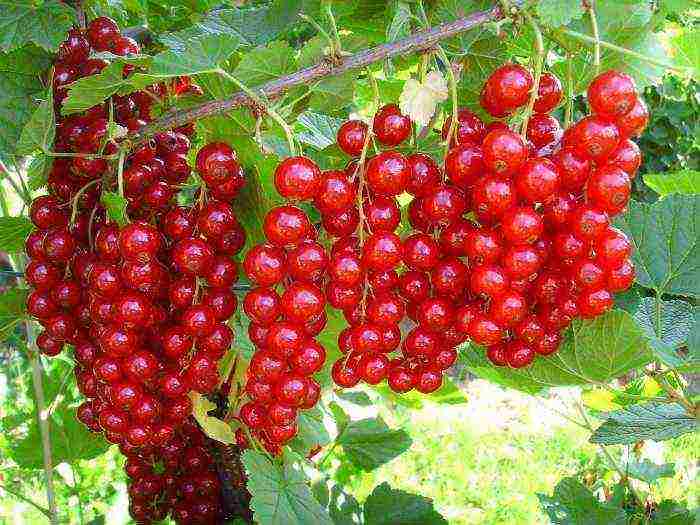
Representative of early ripe varieties of large-fruited red currant. The bush is tall (about 2 meters), slightly spreading. Fruit clusters are long (9-11 cm), up to 15 berries with a weight of 0.8-1 grams are formed on them, they have a flat-round shape, covered with a dense skin of bright red color. The fruits tolerate transportation well, the variety painlessly tolerates sudden changes in temperature, winter-hardy, immune to pests. The yield of one bush is 6-9 kg.
Back to contents ↑ Ural beauty
High-yielding mid-season variety. The bush is short, slightly spreading and has dense foliage. The fruits have a rounded shape, reaching biological ripeness, the skin becomes red. The size of the berries is quite large, their weight ranges from 0.8 to 1.7 grams, sweet in taste. This variety is valued for its winter hardiness and stable high fruiting (8-15 kg per bush), is immune to powdery mildew and is practically not attacked by moths and sawflies.
back to contents ↑ Filippok
A variety of Siberian selection with medium early periods of reaching the biological ripeness of berries. The bush is compact, medium-sized. The brushes are about 18 cm long, they can form up to 25 large (0.5-1.2) round-shaped berries, they are covered with red skin, and have a sour-sweet taste. The variety is moderately resistant to septoria and anthracnose and is highly regarded for its good tolerance to dry, hot weather. The yield of the bush is on average 2.5-3 kg.
back to contents ↑ Crispy

A variety of currants with mid-early ripening of berries, bred by breeders of Siberia. The bush is short, medium spreading. The length of fruit clusters reaches 8-10 cm, the shape of the berries is round, the weight does not exceed 1.3 grams, sweet in taste, the skin is red. The variety is practically immune to anthracnose and septoria, winter-hardy, usually up to 3.5 kg of yield is obtained from one bush.
back to contents ↑ Yuterborgskaya
A mid-season high-yielding variety bred by Western European breeders. Sprawling bush with dense foliage, average plant height. Fruit clusters are about 10 cm long and can contain up to 10-20 round-shaped berries, the diameter of which usually exceeds 1 cm. Fruits can be on the branches of the bush for a long period without losing their taste. From a single bush, you can get no more than 8 kg of harvest.
Red currant is most often allowed for processing, it has a sweet and sour taste, so not everyone likes it. But for compotes, jam or preserves, it is difficult to find a more suitable berry.There are many types of plants, but not many have heard of them, but you need to know about them, because each variety has its own characteristics: the size of the berry, its sweetness, yield, ripening period. The best varieties of red currants for growing in a suburban area will be described below in the article.
How to choose currants according to the ripening period?
Depending on the ripening period, the crop can be harvested at different periods of the summer. This is especially important if the site is located in northern latitudes. If you plant late varieties there, you may not wait for the harvest.
Early ripe red currants ripen from mid-June to mid-July. Among the best varieties, the following three are worth highlighting.
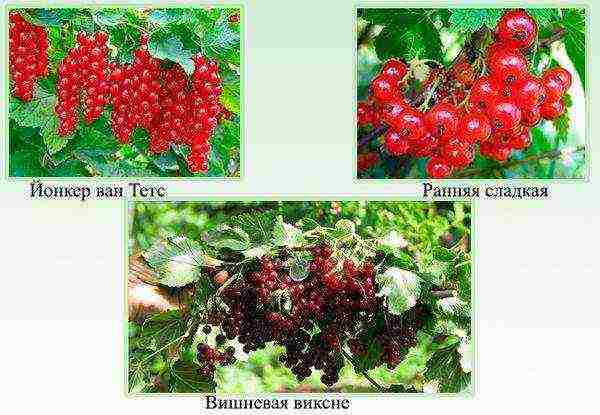
Currant varieties 1
- "Jonker van Tets" - a very old variety, ripens by the end of June. It was taken out in Holland back in 1941. The bush is high, spreading. The berries reach a weight of 0.7 g and have a sweet and sour taste. From year to year it gives a stable harvest, rarely gets sick, resistant to frost, but not suitable for northern regions. Resistant to anthracnose and powdery mildew.
- "Cherry viksne" - an interesting Latvian variety that ripens by the end of June. Its peculiarity is cherry-colored berries, 0.8 grams each. It is very well transported, so it is most often grown for sale. According to the tasting assessment, the taste is rated at 4.5 points out of 5 existing ones. The berries are sweet and sour, but tender. There are few seeds and they are very small.
- "Early sweet" ripens by early or mid-July. Despite the name, the berries (9 g) are more sour than sweet, and have a dark red skin. The bush is resistant to severe frosts, drought, some diseases, pests.
Mid-ripening currants usually have very large berries and a sweeter taste.
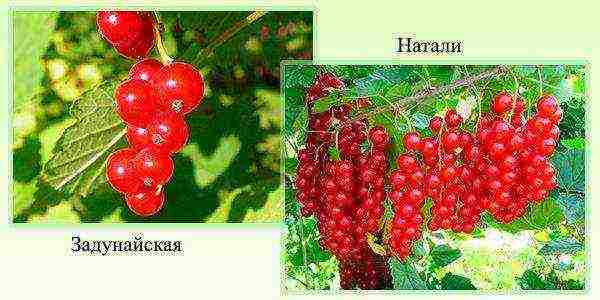
Currant varieties 2
- "Zadunaiskaya" red currants ripen in the second or third decade of July. The berries weigh 0.9 grams, juicy, refreshingly sweet. The advantage is frost resistance and resistance to diseases, pests. Disadvantage - the branches fall under the weight of the harvest, so it is recommended to tie them up.
- "Natalie" ripens around mid-July. Berry weight 1 g, dark red. Withstands frosts down to -30 degrees, transportable. It is highly recommended to prune the bush in time, otherwise it will grow strongly. Taste quality on top. The plant is valued for its pleasant sweetish taste, usually consumed fresh.
The best late-ripening red currant varieties ripen from the beginning of August. They give a large harvest of tasty, sweet berries.

Currant varieties 3
- "Rondom" has large berries - 0.9 g, juicy, sweetish, with a refreshing note. Transportable, can be stored for a long time directly on the bush after ripening. A big advantage is resistance to frost and the ability to plant in any way, in any area.
- "Dana" - a strong spreading bush, has large berries weighing up to 0.9 grams, the color is dark pink. It is resistant to frost, pests, but sharp frosts can lead to the death of the plant. Gives big yields.
- "Lapland" recommended for planting in northern regions. The variety is not afraid of frosts, pests and diseases, but to increase the yield, it needs high-quality care: weeding, pruning, processing. Red berries 0.7 g of excellent taste - universal use.
What varieties have high yields?
Productivity is one of the main criteria for choosing a variety. A small harvest is unlikely to please gardeners, because so much effort and money has been invested in the bush. What are the best red currant varieties that have the highest yields?
- "Dutch red" - Western European, late-ripening variety resistant to low temperatures, diseases and pests. The berries are sweetish, red and rather large, so that 14-15 kg of currants can be harvested from one bush per year.
- "Rondom" is one of the best for the middle climatic zone. The berries are medium in size, 8-11 kg of currants per year are collected from the bush.The berries are transportable, do not spoil for a long time.
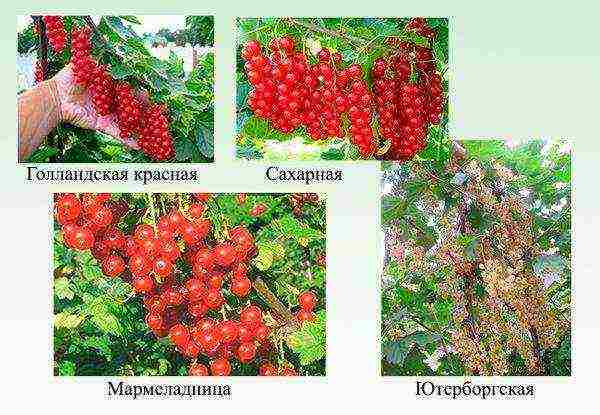
Currant varieties 4
- "Sugar" currant is an early maturing variety. It tolerates frost well, is not afraid of pests, but due to its thin peel, it cannot be transported over long distances. At the beginning of the season, it produces large clusters up to 15 cm long, by the end of the season the berries become smaller. Productivity 6-9 kg per bush.
- "Marmalade" is a late-ripening red currant. The berries weigh up to 0.9 g, and about 6-8 kg of fruits are collected from the bush. The advantage of the variety is that it is practically immune to disease.
- "Yuterborgskaya" has a yield of 8 kg per bush. It is transportable, can be on the branches for a long time after ripening without spoiling and without losing taste. Refers to varieties of medium ripening.
What are the best large-fruited varieties?
The best large-fruited red currant varieties are usually capricious. The size of the berries is directly affected by care, so the bushes are planted far from each other, properly cut, processed to get a high-quality harvest.
Among the largest-fruited varieties, the first place is shared by "Uralskaya krasavitsa" and "Ilyinka", the size of their fruits reaches 1.6-1.7 g. In second place are "Barbara" and "Alpha", their berries weigh about 1.5 g. place, with a berry size of 1 g, is occupied by "Scarlet Dawn", "Asora" and the aforementioned "Natalie".


